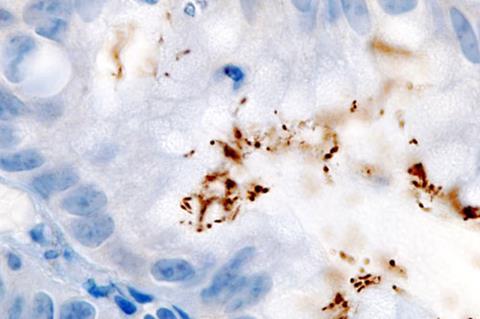Helicobacter pylori (H. pylori) is a common pathogen that can be transmitted from person to person. Long-term H. pylori infection has been recognized as a Class I human carcinogen. Currently, the standard clinical treatments for H. pylori infection (i.e., triple and quadruple therapy) rely on oral antibiotics to clear H. pylori from the stomach.

However, antibiotic resistance in H. pylori has led to an increase in the failure and recurrence rates of clinical treatments over the years. Oral antibiotics can lead to an imbalance of the intestinal flora. In addition, clinical standard therapies such as triple therapy ignore vacuolar toxin A, a vital virulence factor in H. pylori infection.
A research team led by Prof. Yang Lihua from Hefei National Research Center for Physical Sciences at the Microscale, the University of Science and Technology of China (USTC) of the Chinese Academy of Sciences, has developed a nanoparticle-based sonodynamic therapy to reduce H. pylori infection in mouse without disrupting gut microbiota. The study was published in Nature Communications.
Dual efficacy
The nanoparticles that mediate this sonodynamic therapy have been approved for clinical use and have dual efficacy in this therapy. The therapy neutralizes vacuolating cytotoxin A, a key virulence factor secreted by H. pylori in a high efficiency, even without the presence of ultrasound. When combined with an ultrasound exposure dosage that meets the criteria for the use of ultrasound medical devices, it kills H. pylori through the production of reactive oxygen species, offering the possibility of addressing antimicrobial drug resistance.
In female mouse models infected with H. pylori, this sonodynamic therapy worked comparably to the standard triple therapy when it came to lower gastric infections. Unlike antibiotic-based clinical standard therapies, it did not have a significant negative impact on the intestinal microbiota, except for an upregulation on mouse intestinal levels of Lactobacillus, a beneficial bacterium widely used in yoghurt and probiotic products. Besides, it did not adversely affect liver or kidney function or overall health of the mice within 48 hours of treatment administration, consistent with the safety standard of triple therapy.
However, a significant difference in the levels of interleukin-1 receptor antagonist (IL-1RA), a protein that plays a key anti-inflammatory role in a variety of diseases, was observed at 12 weeks post-treatment: the triple therapy up-regulated serum IL-1RA levels in the mice, whereas the sonodynamic therapy did not.
This study presents a promising alternative to the current antibiotic-based therapies for H. pylori infection, offering a reduced risk of antimicrobial resistance and minimal disturbance to the gut microbiota.







No comments yet